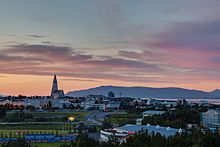
Back اقتصاد آيسلندا Arabic Эканоміка Ісландыі Byelorussian Икономика на Исландия Bulgarian Economia d'Islàndia Catalan Ekonomika Islandu Czech Islands økonomi Danish Wirtschaft Islands German Economía de Islandia Spanish اقتصاد ایسلند Persian Économie de l'Islande French
 | |
| Currency | Icelandic króna (ISK, kr) |
|---|---|
| Calendar year | |
Trade organisations | EFTA, EEA, OECD, WTO |
Country group | |
| Statistics | |
| Population | |
| GDP | |
| GDP rank | |
GDP growth |
|
GDP per capita | |
GDP per capita rank | |
GDP by sector |
|
| 9.8% (March 2023)[6] | |
Population below poverty line | |
| 23.7 low (2019)[9] | |
| |
Labour force | |
Labour force by occupation |
|
| Unemployment | |
Average gross salary | 553,000 ISK / €4,000 month |
| 388,000 ISK / €2,800 month | |
Main industries | tourism, fish processing; aluminum smelting; geothermal power, hydropower; medical/pharmaceutical products |
| External | |
| Exports | |
Export goods | fish and fish products (42%), aluminum (38%), agricultural products, medicinal and medical products, ferro-silicon (2015) |
Main export partners |
|
| Imports | |
Import goods | refined petroleum, aluminum oxide, carbon/graphite electronics, cars, packaged medicines (2019) |
Main import partners |
|
FDI stock | |
Gross external debt | |
| Public finances | |
| +1.5% (of GDP) (2017 est.)[5] | |
| Revenues | 10.39 billion (2017 est.)[5] |
| Expenses | 10.02 billion (2017 est.)[5] |
| Economic aid | c. $40 million (0.24% GDP, 2015 budget) |
Moody's Investors Service[15]
| |
All values, unless otherwise stated, are in US dollars. | |
The economy of Iceland is small and subject to high volatility. In 2011, gross domestic product was US$12 billion, but by 2018 it had increased to a nominal GDP of US$27 billion. With a population of 387,000, this is $55,000 per capita, based on purchasing power parity (PPP) estimates.[16] The 2008–2011 Icelandic financial crisis produced a decline in GDP and employment that has since been reversed entirely by a recovery aided by a tourism boom starting in 2010. Tourism accounted for more than 10% of Iceland's GDP in 2017.[17] After a period of robust growth, Iceland's economy is slowing down according to an economic outlook for the years 2018–2020 published by Arion Research in April 2018.[18]
Iceland has a mixed economy with high levels of free trade and government intervention. However, government consumption is less than other Nordic countries. Hydro-power is the primary source of home and industrial electrical supply in Iceland.[19]
In the 1990s Iceland undertook extensive free market reforms, which initially produced strong economic growth. As a result, Iceland was rated as having one of the world's highest levels of economic freedom[20] as well as civil freedoms. In 2007, Iceland topped the list of nations ranked by Human Development Index[21] and was one of the most egalitarian, according to the calculation provided by the Gini coefficient.[22]
From 2006 onwards, the economy faced problems of growing inflation and current account deficits. Partly in response, and partly as a result of earlier reforms, the financial system expanded rapidly before collapsing entirely in a sweeping financial crisis. Iceland had to obtain emergency funding from the International Monetary Fund and a range of European countries in November 2008. The economy has since rebounded, beginning in 2010.

- ^ "Groups and Aggregates Information". IMF.org. International Monetary Fund.
- ^ "World Bank Country and Lending Groups". datahelpdesk.worldbank.org. World Bank. Retrieved 29 September 2019.
- ^ "Statistics Iceland: The population increased by 2.0% in 2021".
- ^ a b c d e "Report for Selected Countries and Subjects: April 2024". imf.org. International Monetary Fund.
- ^ a b c d e f g h i j k l m n "The World Factbook". CIA.gov. Central Intelligence Agency. Retrieved 4 December 2019.
- ^ "Consumer price index". Statistics Iceland. Retrieved 1 April 2023.
- ^ Statistics Iceland, Retrieved 4 August 2015
- ^ "People at risk of poverty or social exclusion". ec.europa.eu/eurostat. Eurostat.
- ^ "Gini coefficient of equivalised disposable income - EU-SILC survey". ec.europa.eu/eurostat. Eurostat.
- ^ a b "Human Development Index (HDI)". hdr.undp.org. HDRO (Human Development Report Office) United Nations Development Programme.
- ^ "Labor force, total - Iceland". data.worldbank.org. World Bank. Retrieved 1 April 2023.
- ^ "Employment rate by sex, age group 20-64". ec.europa.eu/eurostat. Eurostat. Retrieved 1 November 2019.
- ^ "Unemployment by sex and age - monthly average". appsso.eurostat.ec.europa.eu. Eurostat. Retrieved 4 October 2020.
- ^ "Unemployment rate by age group". data.oecd.org. OECD. Retrieved 8 September 2020.
- ^ a b c Iceland Ministry of Finance and Economic Affairs, Retrieved 22 September 2022
- ^ Source: Statistics Iceland.
- ^ Cite error: The named reference
Tourismwas invoked but never defined (see the help page). - ^ "Economic Outlook: Caution, fragile!". Research - all news - Arionbanki. Archived from the original on 2018-05-15. Retrieved 2018-05-14.
- ^ Christopher Mims. "One Hot Island: Iceland's Renewable Geothermal Power". Scientific American. Retrieved 3 March 2015.
- ^ Iceland: One of the world´s most free economies Archived 2008-09-13 at the Wayback Machine, Invest in Iceland Agency
- ^ Human Development Index Archived July 2, 2015, at the Wayback Machine
- ^ "Human Development Report 2007/2008 - Inequality measures, ratio of richest 10% to poorest 10%". Hdrstats.undp.org. 2010-11-04. Archived from the original on 2009-02-12. Retrieved 2012-02-20.
© MMXXIII Rich X Search. We shall prevail. All rights reserved. Rich X Search